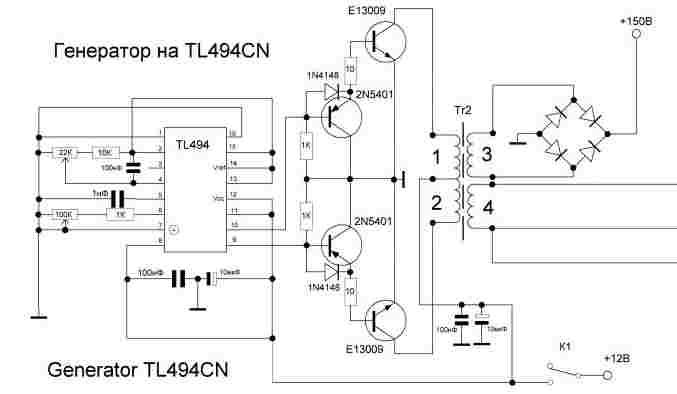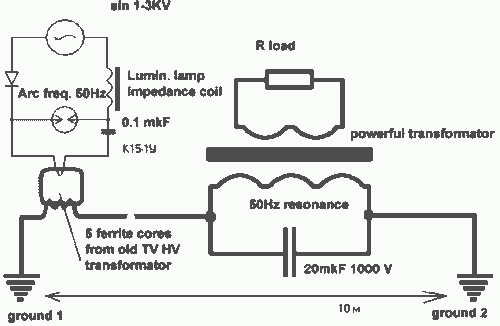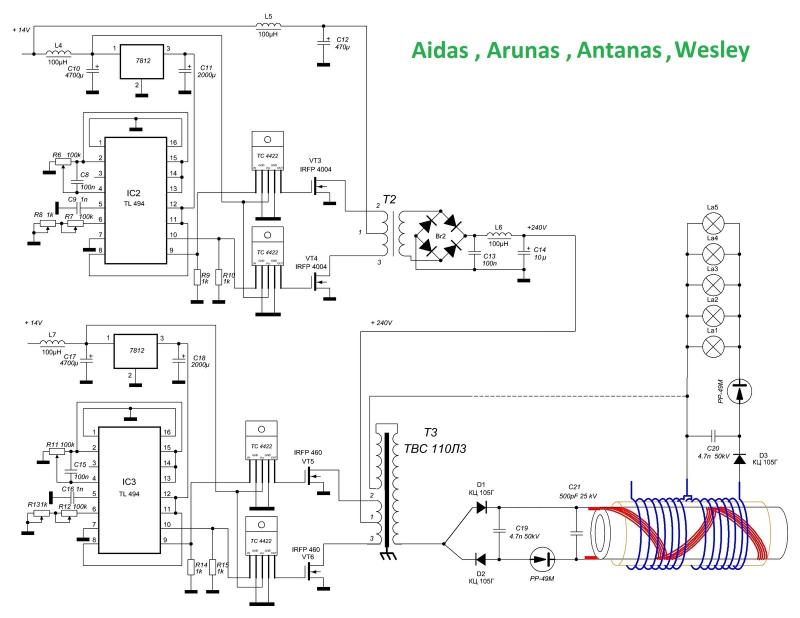
Kapanadze 6


If the scope probes are not isolated, it is still possible to connect the grounding leads of the probes to point A while connecting the tips of the probes to points B and C. The resulting current traces will be inverted unless the inverting function is disabled in the scope's channel setup. The schematic diagram below accurately represents the constructed circuit and also illustrates the internal transistors of the TL494 (the numbers in blue circles indicate the TL494 pin numbers), with a different drawing style. This indicates that any MOSFET with internal parasitic diodes may cause issues, suggesting the use of additional Schottky diodes or snubbers as a solution. Alternatively, one could switch to transistors as shown in the diagram. However, this may introduce other spiking problems. Therefore, the preferred approach is to use MOSFETs with Schottky diodes and 17V snubber zeners. It is advisable to place the 0.1 µF ceramic capacitors on the drain current paths as illustrated in the attached diagram.
The described circuit involves the use of scope probes for measuring voltage and current in a system where isolation may not be present. In such cases, connecting the grounding leads of the probes to a common point (point A) while measuring at two different points (B and C) allows for the observation of current traces. It is crucial to note that the inversion of traces can be managed by adjusting the settings on the oscilloscope.
The schematic referenced includes the TL494, a popular PWM controller, which is commonly used in power supply applications. The internal transistors of the TL494 are essential for its operation, and the pin numbers indicated in blue circles aid in identifying their functions. This schematic serves as a guide for those constructing or analyzing similar circuits.
The discussion regarding MOSFETs highlights the importance of addressing issues related to internal parasitic diodes that can lead to undesired behavior in the circuit. The recommendation to utilize additional Schottky diodes or snubber circuits helps mitigate these effects by providing a path for reverse currents and reducing voltage spikes. The alternative suggestion of using transistors may lead to complications such as increased spiking, which should be carefully considered in the design process.
Incorporating 0.1 µF ceramic capacitors on the drain current paths, as illustrated in the schematic, further enhances the stability and performance of the circuit by filtering high-frequency noise and improving transient response. This design consideration is critical in ensuring the reliability and accuracy of the measurements obtained from the oscilloscope.If your scope probes are not isolated then it's still no problem because you can connect the grounding leads of your probes to point A and the tips of your probes to points B and C. Yes, the resulting current traces will be inverted, but only if you don't enable that inverting function in your scope's channel setup.
BTW: The schematic diagram below represents exactly what you have built, but it also shows the internal TL494 transistors (the numbers in blue circles are the TL494 pin numbers) and this schematic is just drawn in a different manner.
🔗 External reference
The described circuit involves the use of scope probes for measuring voltage and current in a system where isolation may not be present. In such cases, connecting the grounding leads of the probes to a common point (point A) while measuring at two different points (B and C) allows for the observation of current traces. It is crucial to note that the inversion of traces can be managed by adjusting the settings on the oscilloscope.
The schematic referenced includes the TL494, a popular PWM controller, which is commonly used in power supply applications. The internal transistors of the TL494 are essential for its operation, and the pin numbers indicated in blue circles aid in identifying their functions. This schematic serves as a guide for those constructing or analyzing similar circuits.
The discussion regarding MOSFETs highlights the importance of addressing issues related to internal parasitic diodes that can lead to undesired behavior in the circuit. The recommendation to utilize additional Schottky diodes or snubber circuits helps mitigate these effects by providing a path for reverse currents and reducing voltage spikes. The alternative suggestion of using transistors may lead to complications such as increased spiking, which should be carefully considered in the design process.
Incorporating 0.1 µF ceramic capacitors on the drain current paths, as illustrated in the schematic, further enhances the stability and performance of the circuit by filtering high-frequency noise and improving transient response. This design consideration is critical in ensuring the reliability and accuracy of the measurements obtained from the oscilloscope.If your scope probes are not isolated then it's still no problem because you can connect the grounding leads of your probes to point A and the tips of your probes to points B and C. Yes, the resulting current traces will be inverted, but only if you don't enable that inverting function in your scope's channel setup.
BTW: The schematic diagram below represents exactly what you have built, but it also shows the internal TL494 transistors (the numbers in blue circles are the TL494 pin numbers) and this schematic is just drawn in a different manner.
So this means any MOSFET with internal parasitic diodes are causing this, meaning use your suggested method of extra Shottky diodes/snubbers, or as an alternative; swap to transistors like in the diagram below? But then i probably will run in all sorts of other spiking problems, right? So i will go for the MOSFETs with Shottky diodes and my 17V snubber zeners. It is much better to put the 0.1Ω CSRs on drain current paths as illustrated on the attached diagram.
🔗 External reference

